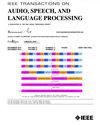Optimization Techniques to Improve Training Speed of Deep Neural Networks for Large Speech Tasks
IEEE Transactions on Audio Speech and Language Processing
Pub Date : 2013-11-01
DOI:10.1109/TASL.2013.2284378
引用次数: 61
Abstract
While Deep Neural Networks (DNNs) have achieved tremendous success for large vocabulary continuous speech recognition (LVCSR) tasks, training these networks is slow. Even to date, the most common approach to train DNNs is via stochastic gradient descent, serially on one machine. Serial training, coupled with the large number of training parameters (i.e., 10-50 million) and speech data set sizes (i.e., 20-100 million training points) makes DNN training very slow for LVCSR tasks. In this work, we explore a variety of different optimization techniques to improve DNN training speed. This includes parallelization of the gradient computation during cross-entropy and sequence training, as well as reducing the number of parameters in the network using a low-rank matrix factorization. Applying the proposed optimization techniques, we show that DNN training can be sped up by a factor of 3 on a 50-hour English Broadcast News (BN) task with no loss in accuracy. Furthermore, using the proposed techniques, we are able to train DNNs on a 300-hr Switchboard (SWB) task and a 400-hr English BN task, showing improvements between 9-30% relative over a state-of-the art GMM/HMM system while the number of parameters of the DNN is smaller than the GMM/HMM system.提高大型语音任务深度神经网络训练速度的优化技术
虽然深度神经网络(dnn)在大词汇量连续语音识别(LVCSR)任务中取得了巨大的成功,但训练这些网络的速度很慢。即使到目前为止,训练dnn最常见的方法是通过随机梯度下降,在一台机器上连续进行。串行训练,再加上大量的训练参数(即1000 - 5000万个)和语音数据集规模(即2000 -1亿个训练点),使得DNN训练对于LVCSR任务来说非常缓慢。在这项工作中,我们探索了各种不同的优化技术来提高深度神经网络的训练速度。这包括交叉熵和序列训练期间梯度计算的并行化,以及使用低秩矩阵分解减少网络中参数的数量。应用提出的优化技术,我们表明DNN训练可以在50小时的英语广播新闻(BN)任务中加速3倍,而准确性没有损失。此外,使用所提出的技术,我们能够在300小时的交换机(SWB)任务和400小时的英语BN任务上训练DNN,相对于最先进的GMM/HMM系统,DNN的参数数量比GMM/HMM系统少,显示出9-30%的改进。
本文章由计算机程序翻译,如有差异,请以英文原文为准。
求助全文
约1分钟内获得全文
求助全文
来源期刊
自引率
0.00%
发文量
0
审稿时长
24.0 months
期刊介绍:
The IEEE Transactions on Audio, Speech and Language Processing covers the sciences, technologies and applications relating to the analysis, coding, enhancement, recognition and synthesis of audio, music, speech and language. In particular, audio processing also covers auditory modeling, acoustic modeling and source separation. Speech processing also covers speech production and perception, adaptation, lexical modeling and speaker recognition. Language processing also covers spoken language understanding, translation, summarization, mining, general language modeling, as well as spoken dialog systems.

 求助内容:
求助内容: 应助结果提醒方式:
应助结果提醒方式:


